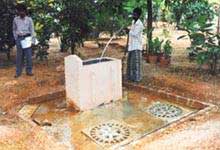


Builder R Jeyakumar's technique is simple and cost-effective. The areas surrounding building complexes in Chennai are cemented. The rain water is allowed to flow on to the road. The first step, says Jeyakumar, is to prevent this run-off by two to three-inch-high kerbs near the gates. To collect the run-off, a 23-cm-wide, 12-cm-deep canal or trench is dug along the periphery of the plot. To catch rainwater, a series of bore pits are drilled along the drain. Each bore pit is connected to the drain through a slanting pipe. The bore pits are filled with broken bricks and sand or pebbles. A four-cubic cm collection chamber is provided on the top, filled with broken bricks and a 'silt-arrester'. Excess water flows into the bore pits and into the ground water aquifers.
Links:
[1] http://admin.indiaenvironmentportal.org.in/feature-article/citys-thirst
[2] http://admin.indiaenvironmentportal.org.in/category/newspaper/down-earth
[3] http://admin.indiaenvironmentportal.org.in/category/thesaurus/water-harvesting
[4] http://admin.indiaenvironmentportal.org.in/category/thesaurus/urban-habitat
[5] http://admin.indiaenvironmentportal.org.in/category/thesaurus/rural-habitat
[6] http://admin.indiaenvironmentportal.org.in/category/thesaurus/global
[7] http://admin.indiaenvironmentportal.org.in/category/thesaurus/developing-countries